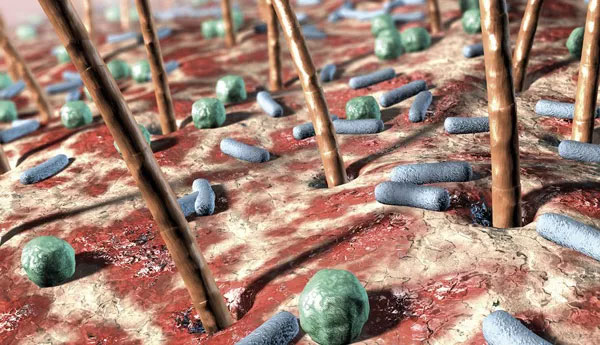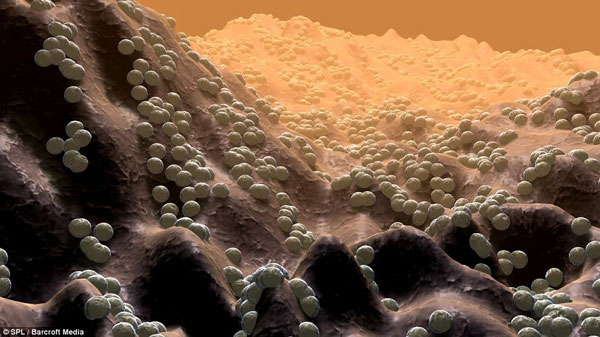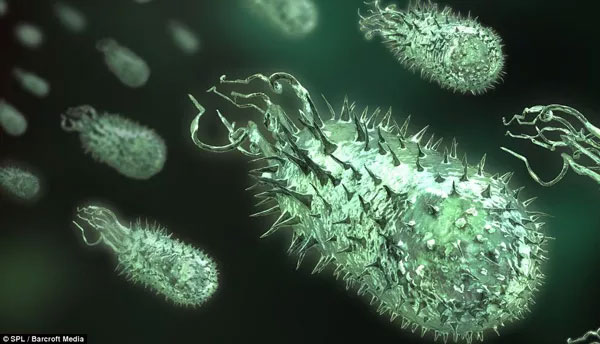The 'amazing' world of bacteria in the human body
A new study confirms the usefulness and importance of bacteria for the human body.
Learn what types of bacteria live in the human body
Many people still think that bacteria are 'uninvited' guests who enter the body and cause all sorts of troublesome illnesses. However, they actually account for up to 90% of living cells in the body (human intestinal tract alone contains up to 2kg of bacteria) and plays a very important role.

Super-realistic images of tiny microbes (green and blue) on our skin.There are many types of bacteria found on the skin, especially in the sweat glands and hair follicles, which are also the cause of obnoxious acne.

Exaggerated image of the bacterium bacteria on the surface of the cell.Each of these microbes is a completely living organism.
Dr. Roy D.Sleator, lecturer of Cork Institute of Technology, Kerry County, Ireland spent 4 years researching the topic of human interaction and bacteria to learn about the effects of they are for our body.
'Bacteria need to be considered as a true part of the body with much higher productivity than the liver.'
In the past, the role of natural bacteria was largely overlooked, but the latest analysis of DNA structure in the environment revealed the diversity and practicality of this microbial community. There are about 500 different species of bacteria in the human body. In an adult, the estimated number is about 100 trillion cells.

Impressive images of bacteria e.Coli are using their tails to 'swim' in our gut.

Photo of the sequence of Streptococcus pneumoniae bacteria, one of the causes of pneumonia.
The number of parasitic germs that can be harmful to us can be said to be quite large but in general, most bacteria exist to be useful for our bodies, helping people stay healthy and longer. . The interaction between people and bacteria is a symbiotic relationship. They absorb food in our bodies but in turn help people produce vitamins, increase the ability to digest and enhance the immune system, helping to counteract the effects of 'bad' bacteria or dangerous pathogens. .
As we can see in nature, pets are often more susceptible to disease and have a much shorter lifespan than wild animals, even though they live in a much cleaner, safer environment. It is the most vivid proof for the important role of bacteria.

The tail part of a typical rod-shaped bacterium with small feathers grows bristling.Representatives of them can include Escherichia coli and Salmonella (bacteria that cause food poisoning).

Other rod-shaped bacteria with the first capillary (hair-like structure) in the tail to help them move.
- Infiltrate the world of bacteria inside the human body
- Amazing discovery of the human body
- 39 trillion bacteria on the human body
- 99% of bacteria in the human body are not known
- Find out how to determine the time of death through human bacteria
- Bacteria determine people's lifespan?
- The truth 'silly' is not everyone knows about his body
- Amazing things about the human body
- Bacteria, an inevitable part of ... humanity
- Video: Two lines penetrate the body of the human cannibalistic bacteria
- Science says: More than half of your body is not human!
- 20 somewhat horrifying truths related to the human body
 Why do potatoes have eyes?
Why do potatoes have eyes? 'Tragedy' the world's largest carnivorous life: Death becomes ... public toilet
'Tragedy' the world's largest carnivorous life: Death becomes ... public toilet Tomatoes were once considered 'poisonous' for 200 years
Tomatoes were once considered 'poisonous' for 200 years Detecting microscopic parasites on human face
Detecting microscopic parasites on human face